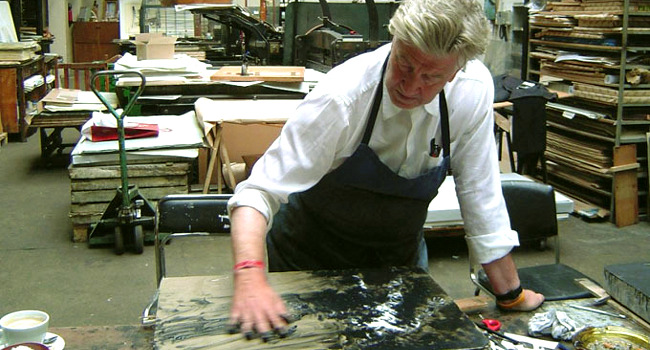While David Lynch is known for his film and television projects, he started out as a painter and has maintained a studio practice throughout his weird and wonderful career in moving images. While Lynch’s fear of being seen as a “celebrity painter” has kept him from pursuing gallery exhibitions, he’s been pleased to accept showings that have been offered to him.
While this is kind of a nonchalant way to go about building a reputation in the fine arts, Lynch’s casual approach has paid off in yesterday’s announcement that David Lynch — the painter — will be given his first museum retrospective at the Pennsylvania Academy — a telling location for Lynch and his surreal canvases.
Here are some of the details from the New York Times…
LOS ANGELES — David Lynch’s rooftop painting studio, perched high in the Hollywood Hills, is littered with the byproduct of work. Paintings with crude, childlike figures doing menacing things lean up against the walls, unfinished drawings are strewn over his huge desk, and the floor is carpeted with cigarette butts. While the dark visual sensibility of his film work — “Eraserhead” (1977), “The Elephant Man” (1980), “Blue Velvet” (1986), “Wild at Heart” (1990), “Mulholland Drive” (2001), and his TV series “Twin Peaks” (1990-91) — has permeated the public consciousness and widely influenced other filmmakers, writers and artists (including Cindy Sherman and Gregory Crewdson), Mr. Lynch’s own visual art is almost unknown. Yet painting is where he started, enrolled as an advanced student at the Pennsylvania Academy of the Fine Arts in Philadelphia in 1966 and ’67, and it is the medium he continues to work in most actively. His first United States museum retrospective, “David Lynch: The Unified Field,” opens at the Pennsylvania Academy on Sept. 13.
“I loved my time at the academy,” Mr. Lynch said, drinking coffee and smoking at his desk, his genial small-town manner a vivid counterpoint to the eerie tenor of his films. “The building was almost black. All of Philadelphia had a kind of coal-dust patina and a mood that was just spectacular. There was violence and fear and corruption, insanity, despair, sadness, just in the atmosphere in that city. I loved the people there. All these things, whatever way it was, was my biggest influence.”
Despite the cultlike devotion to Mr. Lynch’s films, “nobody’s paid attention to him in terms of my colleagues at American museums,” observed Robert Cozzolino, the senior curator of the Pennsylvania Academy, who organized the show. It brings together paintings and drawings from five decades and includes a trove of barely exhibited early work from Mr. Lynch’s time in Philadelphia that set the tone for everything that followed.
Congratulations, Mr. Lynch! Here’s an interview with Lynch in his art studio talking about the moment he became a visual artist…
Stay Awake!
Please subscribe to my YouTube channel where I archive all of the videos I curate at Insomnia. Click here to check out more Art posts.









